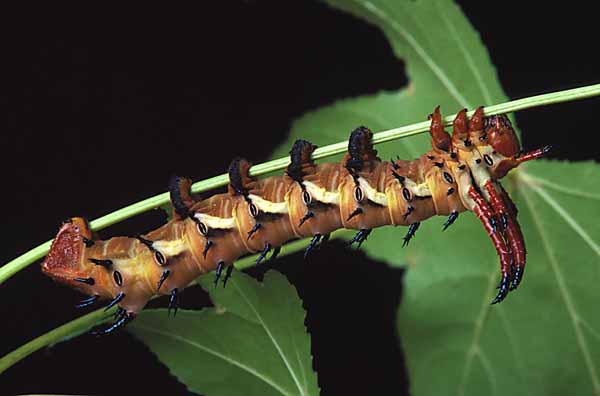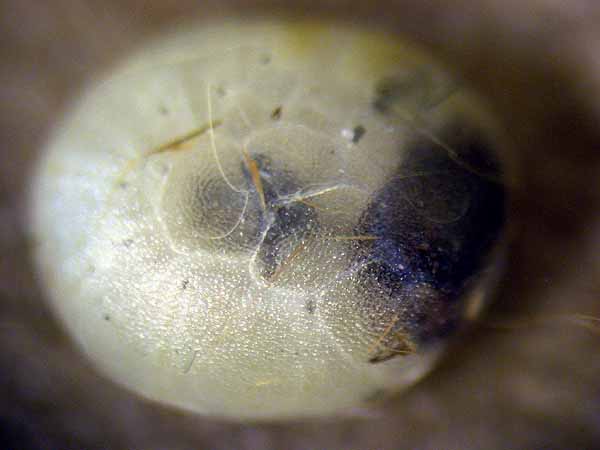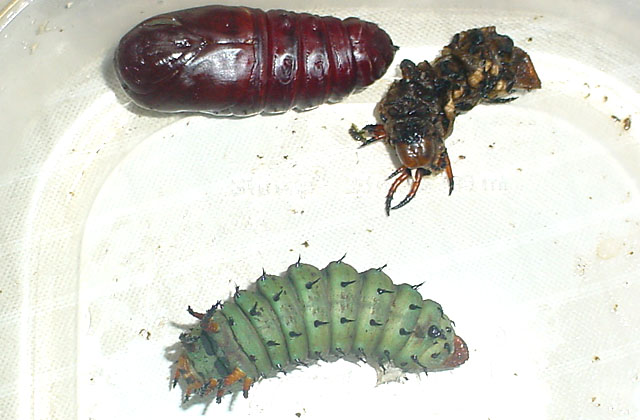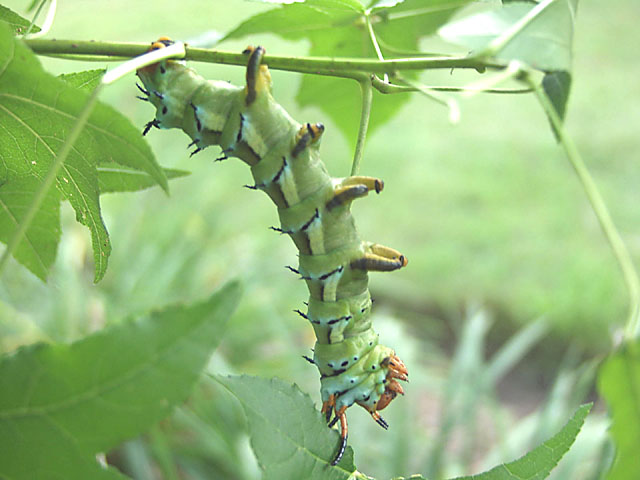Citheronia regalis: Do's and Don'ts
by Bill Oehlke

Citheronia regalis caterpillar, copyright protected, courtesy of Bob Jensen

Citheronia regalis caterpillar, copyright protected, courtesy of Bob Jensen
The spectactular size and "weaponry" of Hickory Horned-Devil larvae can't help but impress all those who rear them. For such a monstrous larvae (often exceed six inches), they are relatively easy to rear. Final instar larvae are most often green, sometimes taking on a bluish hue prior to pupation. This article presents the "Do's and Don'ts" for a successful rearing program.

Larva developing inside the egg, courtesy of Louis Dawson.
Louise Dawson writes, "The Citheronia ova are so cool! I can clearly see the developing larva inside and even see them move through my 20X fieldscope. They look like little light yellowish donuts inside with dark heads." My experience has been that incubation takes about ten days, and the dark heads will become visible through the eggshell at around the seventh day. This seems to be true of many of the large Ceratocampinae.
"Do's":
1) Divide up your regalis eggs so that
you only have a few eggs in a good sized hatching container.
"Don'ts":
1) Don't put foliage in with unhatched
eggs.
2) Don't "put all your eggs in one basket."
Both my father and I have seen Ceratocampinae eggs develop nicely,
with visible larvae forming up, only to have the eggs go unhatched.
Something happens to the developing larvae just before emergence.
Others report this same experience.
We have long known not to put foliage in with
unhatched eggs in a closed container. The results are usually
disastrous and this applies not only to Ceratocampinae eggs. Either
the moisture or the Carbon Dioxide or other gases from the foliage or
a combination apparently suffocates the developing larva inside the
eggshell.
The larva may need a good supply of oxygen at this critical time and
the coating of condensate that forms on the eggs in such cases may
well block the transfer of Oxygen through the micropyle
(little breathing hole). It is also possible that the Carbon Dioxide
buildup from the foliage simply smothers the eggs.
Jeff Shumacher writes, "I just recently received some regalis ova from you (my father). I have a problem: Of the dozen ova I got, only six of them hatched. The others looked like they were developing, but just when it looked like they should be ready to hatch, they died. Of the six that hatched only two of them started eating. I had them on black walnut. Two years ago I had a mating of regalis and the same thing happened to almost all of the ova. I can't figure out what I could have done to cause this to happen."
Jeff indicated he had not put foliage in with unhatched eggs, so I suspect emergent fumes may have "done in" the unhatched eggs.
It is also a good idea to offer hatchlings a variety of leaves from the known host plants list. My father has documented a case where luna hatchlings would not accept the same foliage (willow) which their mother had been fed. My father usually uses willow for his regalis, but sweetgum and sumac have also served well. Hickories, walnuts, gums also work well.
Below is a list of recognized foodplants.
Carya glabra |
Pignut hickory |
"Do's":
1) Offer a couple of potential hosts, but only ones for which you
have sufficient access to get the brood through.
"Don'ts":
1) Try to rely on a single host; it is possible that the larva will
not accept foliage of parents.
2) Choose a host that is in short supply or difficult to access.
"Do's":
2) Gently brush or lift them back onto foliage with your fingertip or
a spoon if they
haven't returned after a couple of hours.
1) Be patient with hatchlings. They have tiny bellies and have
literally
eaten their way out of the eggshell. It is not uncommon for them to
climb along the side of the container and arrange themselves so that
the top of body looks limp and is bent downward toward the anal
claspers. In this typical resting posture, they resemble bird
droppings, and the pose may simply be a camouflage mechanism.
Even after they have started feeding, they frequently leave the foliage, and this can be most annoying in a sleeve where they offer themselves up to stinkbug predation by hanging on the sleeve.
"Don'ts":
Immediately assume they are going to starve to death and won't accept
what you have offered.
If you are offering a variety from the above list, they will probably settle on something. Sometimes they just take little nibbles and then move on. Tiny poop in the bottom of sleeve or container indicates something is eating!
Once larvae have started feeding the hard part is probably over for this species. They seem quite resistant to disease.
"Don'ts":
Caterpillars can overheat in a sleeve without some protection
from foliage. It is remarkable how much heat energy is actually taken
in by foliage. If you burn firewood for heat, all that heat energy in
the wood was taken in by leaves.
I suspect there is also chance for wounds from pointed structures on
forelegs if caterpillars start crawling over each other!
Check on nearly mature larvae regularly. Caterpillars have strong
mandibles and many can actualy chew holes
through various sleeve materials to escape, either looking for food
or a place to pupate.
When you see larvae crawling around at the bottom of the sleeve or
rearing cage/container, it is time to remove them to pupation
chambers. Sometimes larvae take on a slightly bluish tinge when
ready to pupate.
I treat all of the earth pupators (Ceratocampinae, Sphingidae) the
same way. I use dark plastic buckets:
Avoid overcrowding: Despite regalis' resistance to disease,
overcrowding is never a good idea for any species. Too many larvae in
a single sleeve can also result in a "healthy supply" of foliage
disappearing overnight. A day or so without food or the water
incorporated in it, can severely stress larvae.
Empty frass from sleeves frequently, especially before rain (avoids a
soggy mess).
indoors to avoid overheating in direct sunlight and provide warmth
during fall nights;
covered to avoid caterpillar escapees from startling other members of
the household;
and
lined with loose paper towelling so larvae can "descend" to a darker
region.

Considerable brown fluid was discharged by larvae into tubs and this was poured off as it accumulated.
In the image above, I have placed a larva about to pupate in with a pupa and discarded skin. You can see the shriveled nature of the larva. This is typical of all the earth pupators, but not all shrink as much or discharge as much fluid as regalis.
Jeff Schumacher writes: "I know that I've read that
some people have had trouble getting regalis to pupate
successfully. I've found a method that seems to work quite well.
I don't know if you've ever heard of Omaha steaks, but
when you order something from them, they send it in a
styrofoam cooler packed in dry ice. What I've done is
use the cooler as a pupating box. I put a layer of
moist paper toweling in the bottom and a few layers of
newspaper on top of that, and then another layer of
moist paper toweling on top of that. The regalis
larvae burrow to the bottom and pupate. I've found
this method to be very sucessful.
I hope that this information is helpful.
Newly formed pupae are extremely soft and should not be moved/touched
for at least several days to give pupal shell a chance to harden.
It's not good to have larvae crawling over fresh pupae either, so you might want to consider smaller individual chambers for larvae that are ready to pupate. My father has used the individual chambers in a fishing tackle box with good success.
Once the pupae have hardened, they can be cared for as per these instructions from Don Oehlke:
"Pupae can be kept wrapped to keep moisture constant ALL THE WAY to eclosure." (Wrapping consists of taking the hardened pupae and literally wrapping them in a piece of toilet tissue or regular hand tissue paper. Don't make the wrap too tight (taut); placing the pupa at one edge of the tissue and then gently rolling will have the desired effect.)
(In the fall, the wrapped pupae can be placed in storage tubs. A light misting of the tissue will help to conserve moisture and simulate the humidity encountered in the natural subterranean chambers.)
(Check your storage containers once a month throughout the winter and mist wraps if necessary. This monthly check probaly also serves to freshen air in otherwise airtight containers. I store my Sphingidae and Ceratocampinae in ziploc plastic tubs in fridge crisper. See Overwintering Pupae article.)
In the spring, pupae can come out of storage and should be placed in an emergence cage:
"Sprita with water not less than once a day out of direct sun. Temps
should be 70 to 85F with air circulation. As of June 1, they should
be wet down twice per day or more if surrounding air is hot and arid.
Mold will not occur on live pupa. They can
be teased to wiggle by running a fingernail down the abdominal
segments. Remember desiccation is the worst enemy also birds and
rodents. NO HIGH HEAT NO DIRECT SUN."
"They should eclose between 6/15 and 7/15 depending upon warm
temperatures. Do not attempt incubation in air conditioning (they
may not emerge without warmer temps.)
You can place a paper towel on top of covered pupa and make sure you
keep it damp and read Bills' instructions. I have kept these live
for nine months--the rest is up to you!"
Other articles you should read include the following:
Earth Pupators
Overwintering Cocoons and Pupae
An Emergence cage for
Citheronia regalis
The instructions vary slighty from article to article as my father, Scott Smith and I all use slightly different techniques. General principles, however, remain the same.
There may be two broods annually in the extreme south, but generally regalis is a univoltine (single brood) species. Approximating natural outdoor conditions for winter storage for your specific area will probably help with synchronization with natural flight. A hard freeze, however, is not necessary.
Although regalis mate readily in captivity, there seems to be some reluctance for siblings to mate. If you want pairings, you need to be in an area where there are native populations so wild males can be called in, or you need to have pupae from two different brood stocks.

Citheronia regalis on sweetgum, courtesy of Don Adams.
Return to Livestock Page
This article is a sample of what is available on the World's Largest Saturniidae (memberhip) Site